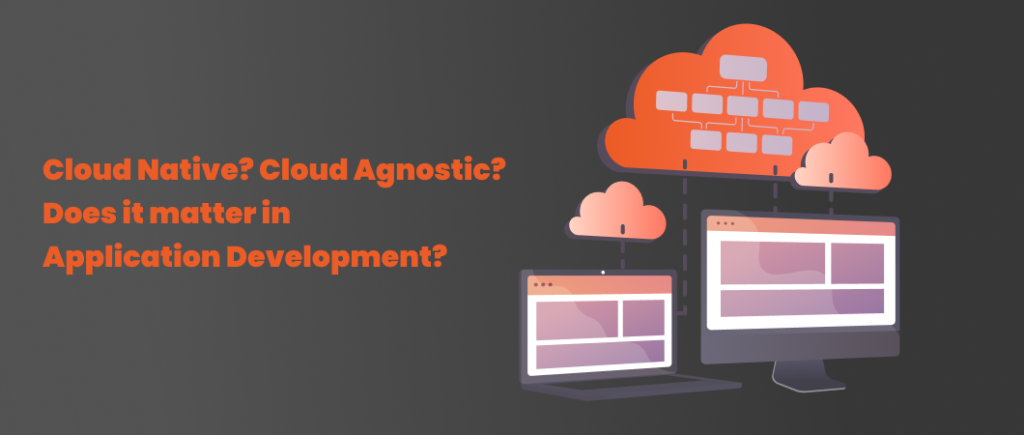Last updated on April 16th, 2024
According to a recent report by Gartner, more than half of enterprise IT spending in key market segments is expected to shift to the cloud by 2025. As cloud technology is enveloping the business landscape, there is growing traction in developing cloud-enabled applications too.
But despite the growing interest, there’s also concernabout how enterprise cloud costs and complexities are spiraling out of control, compelling businesses to ponder over the right approach to application development – cloud-native or cloud-agnostic.
What Are Cloud-Native Applications?
Cloud-native applications are built and run to take advantage of the cloud’s distributed computing capability and exploit the scalability, elasticity, resiliency, and flexibility the cloud provides.
By making use of features such as containers, service meshes, microservices, immutable infrastructure, and advanced application programming interfaces (APIs), cloud-native applications empower organizations to build and run scalable, highly-resilient, and easily-manageable applications in public, private, and hybrid clouds.
But most cloud-native applications are restricted to working within a single cloud platform. Since they leverage the tools and building blocks available from the cloud provider, they are usually tightly integrated to deliver the desired functionality, leading to the risk of vendor lock-in.
What Are Cloud-Agnostic Applications?
Cloud-agnostic applications are designed to run seamlessly in any cloud environment. They are not dependent on any tool chain offered by any cloud platform and can easily integrate with a tailored mix of third-party tools.
While cloud-agnostic applications are arguably known to introduce a degree of risk in terms of tool compatibility and standardized application management, they free organizations from the challenge of vendor lock-in. By prizing characteristics like portability, they work seamlessly across clouds and cloud providers – without impacting user functionality.
The flexibility and freedom offered by cloud-agnostic applications have made them extremely sought-after by development teams. But building and integrating all the required features is often a tedious task for development teams.
Cloud Native vs. Cloud Agnostic
| Aspect | Cloud Native | Cloud Agnostic |
|---|---|---|
| Definition | Built specifically for a particular cloud platform, leveraging its native services and features. | Designed to run on any cloud platform, with minimal dependencies on platform-specific features. |
| Focus | Emphasizes maximizing the benefits of a particular cloud platform, such as scalability, elasticity, and native integrations. | Focuses on portability and flexibility, allowing applications to be deployed across multiple cloud environments without significant modifications. |
| Dependencies | Tightly coupled with the services and features offered by a specific cloud provider. | Minimizes dependencies on proprietary cloud services, utilizing standardized APIs and abstraction layers. |
| Architecture | Often utilizes cloud-specific tools and technologies, such as Kubernetes, AWS Lambda, or Azure Functions. | Relies on open-source technologies and standards to ensure compatibility across different cloud platforms, such as Docker containers and Kubernetes. |
| Vendor Lock-in | May result in vendor lock-in due to reliance on proprietary services and features. | Aims to avoid vendor lock-in by abstracting away platform-specific functionalities and adhering to open standards. |
| Flexibility | Optimized for performance and efficiency within a particular cloud environment. | Offers greater flexibility and choice in selecting cloud providers based on cost, performance, and specific requirements. |
How Do Cloud-Native and Cloud-Agnostic Impacts Application Development?
As enterprise data, tools, and workflows span cloud platforms, enterprise applications have had to follow suit. Almost every enterprise today is rushing to adopt multi-cloud and hybrid-cloud strategies to keep up with the pace of digital change. But unfortunately, the journey to becoming cloud-first has proven to be much harder than many thought initially.
To achieve functionality and simplicity as the modern user expects, development teams need to fold in an immense amount of complexity. They need greater skill and understanding to integrate several customized application elements available from different cloud providers and build an application of choice.
While both cloud-native and cloud-agnostic architecture approaches lead to the same goal of hosting distributed applications in the cloud, let’s look at key differences and see how they impact the application development process:
Development Time
Cloud-native applications allow developers to quickly and easily leverage a host of built-in cloud capabilities, templates, and ready-to-use infrastructure – leading to accelerated time-to-market. Cloud-agnostic applications, in opposition, require developers to build and integrate their unique functionalities – which can be a costly and time-consuming process. Since the development of new features requires a high level of experience and expertise, cloud-agnostic applications are also known to risk competitive advantage.
Flexibility
Cloud-native applications benefit from the cloud platform’s built-in capabilities for security, monitoring, and networking. But most of the out-of-the-box features are very basic. For advanced capabilities, teams are required to subscribe to services and pay additionally. This isn’t generally the case with cloud-agnostic applications – as they offer far more development flexibility. Since developers are not restricted to one cloud platform’s capabilities or tools, they can leverage a range of open-source tools, libraries, and integrations and embrace emerging development trends.
Scalability
Because cloud-native applications are built using a single cloud platform, they offer a restricted level of scalability. Contrastingly, cloud-agnostic apps have the freedom to move across cloud platforms and can be quickly scaled up to meet demand. When migrating on-premises architectures to the cloud, having a cloud-agnostic architecture makes the transition easier – while allowing teams to maintain core business services on-premises.
Cost
Cloud-native applications are more expensive to build and deploy since they depend on a combination of licensing and data storage requirements – as set by the cloud service provider. Cloud-agnostic applications, on the other hand, have greater accessibility to open-source tools, giving application teams more direct control over costs while also offering the ability to make spending adjustments as needed. But for this, teams need to constantly track spending to ensure that money isn’t wasted on tools or services the development team doesn’t use. Also, the cost of recovery from major application failures on the team can lead to a substantial bill.
Cloud Native or Cloud Agnostic – What to Choose?
In an age of uncertain economic times, one would expect trimmed budgets and shelved plans. But that hasn’t been the case. As digital transformation initiatives pick pace, the focus on improving productivity and performance is at an all-time high. This is why most enterprises looking to respond to a fluctuating market and industry dynamics have ramped up their investments in developing cloud-enabled applications.
Whether cloud-native or cloud-agnostic, if you want to survive and thrive, you need to up your cloud game and quickly make the transition. While Gartner termed cloud-native platforms as a Top Strategic Technology Trend for 2022, the route you choose depends entirely on your unique business case.
Even though cloud-native applications are faster to develop and deploy and offer higher levels of security, they cannot just be lifted and shifted from an on-premises environment to the cloud. They call for a fundamental re-architecture to start with and require a completely different approach to developing and testing the application and managing the ongoing evolution.
There’s no right or wrong way to develop an app; it depends on the level of flexibility and scalability you require, the time you have at hand, and your budget. Interested in learning more? Let’s talk.



